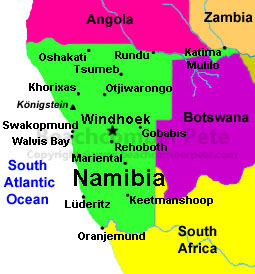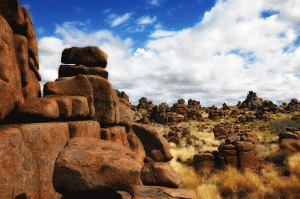 Namibia, a country on the south western coast of Africa, is officially named the Republic of Namibia. Formally a part of South Africa, the country gained independence in 1990 after the Namibian War of Independence. Today, the country is a member of the United Nations. Namibia's economy is still closely tied to South Africa, but it struggles with poverty. With a population of around two million people, the economy is fueled by livestock, agriculture, tourism and mining. Base metals along with gold, uranium and silver are mined. A land that receives abundant sunshine over three hundred days per year, Namibia, Africa, with its coastline and islands, as well as the dry Kalahari Desert, has people and wildlife that have lived in their environment since ancient times. Before the 1400s A.D., Namibia was home to several different native peoples, and the last of these were the Bantu tribes. In the late 1400s, explorers from Portugal landed and scouted the countryside. Still, it was not until the 1800s that European settlers and traders made their homes in the region. Most of these people were from Sweden and Germany. Germany claimed the area a German colony in 1884. In 1915, South Africa took over the country when Germany was defeated in World War I. By the mid-1900s, the people of the country were tired of foreign rule and began working for independence. The struggle continued through the 1980s before 1990 when independence was won.
Namibia, a country on the south western coast of Africa, is officially named the Republic of Namibia. Formally a part of South Africa, the country gained independence in 1990 after the Namibian War of Independence. Today, the country is a member of the United Nations. Namibia's economy is still closely tied to South Africa, but it struggles with poverty. With a population of around two million people, the economy is fueled by livestock, agriculture, tourism and mining. Base metals along with gold, uranium and silver are mined. A land that receives abundant sunshine over three hundred days per year, Namibia, Africa, with its coastline and islands, as well as the dry Kalahari Desert, has people and wildlife that have lived in their environment since ancient times. Before the 1400s A.D., Namibia was home to several different native peoples, and the last of these were the Bantu tribes. In the late 1400s, explorers from Portugal landed and scouted the countryside. Still, it was not until the 1800s that European settlers and traders made their homes in the region. Most of these people were from Sweden and Germany. Germany claimed the area a German colony in 1884. In 1915, South Africa took over the country when Germany was defeated in World War I. By the mid-1900s, the people of the country were tired of foreign rule and began working for independence. The struggle continued through the 1980s before 1990 when independence was won.  Successful at transitioning into an independent nation, today Namibia is bordered by Angola, Zambia, Botswana and South Africa. The capital of the country is located in Windhoek, with Namibia striving to reach out to its neighbors and the United Nations with goodwill and reconciliation. A presidential and democratic government, the president serves a term of five years as head of government and state. A small army of just over seven thousand men and women form the Namibian Defence Force. Namibia has a diverse environment geographically and culturally. The region has five distinct geographical areas including the Kalahari Desert, the Great Escarpment, the Central Plateau, the Bushveld and the Namib Desert. Most of the educational institutions for young people are state run, but some private schools do exist. The most popular sport in the country is football and has a team that competes with other African nations. Other sports are rugby, cricket, inline hocky and more.
Successful at transitioning into an independent nation, today Namibia is bordered by Angola, Zambia, Botswana and South Africa. The capital of the country is located in Windhoek, with Namibia striving to reach out to its neighbors and the United Nations with goodwill and reconciliation. A presidential and democratic government, the president serves a term of five years as head of government and state. A small army of just over seven thousand men and women form the Namibian Defence Force. Namibia has a diverse environment geographically and culturally. The region has five distinct geographical areas including the Kalahari Desert, the Great Escarpment, the Central Plateau, the Bushveld and the Namib Desert. Most of the educational institutions for young people are state run, but some private schools do exist. The most popular sport in the country is football and has a team that competes with other African nations. Other sports are rugby, cricket, inline hocky and more.
In Namibia's constitution, provision is made for protecting natural resources and providing for conservation. Because of the emphasis on conservation, Namibia is an exciting country to visit with its abundance of wildlife and diverse terrain. Many lodges cater to eco-tourism. Extreme and adventure sports found in the region provide opportunities for 4 x 4 tours, sand boarding and backpacking. Some of the highest sand dunes in the world are found in Namib-Naukluft National Park. Some of the other popular places to see in the country are the Skeleton Coast Park, Fish River Canyon, and Caprivi Strip. Visitors can discover the land and people of Namibia, get back to the simple natural life, and take time for viewing spectacular sunsets over dunes or the Atlantic Ocean.






[...] Namibia [...]